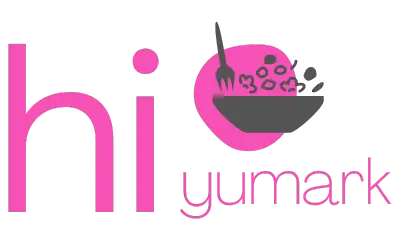Want real Amish breakfast recipes? Think baked oatmeal with a crisp top, sausage gravy poured over biscuits, cinnamon rolls still warm from the oven, and fried cornmeal mush drizzled with syrup. These dishes are hearty, homemade, and meant for mornings that feel slow, cozy, and unforgettable.
Ever had breakfast that feels like a warm hug from your grandma’s kitchen?
Well, that’s kind of what an Amish breakfast is like. No fuss, no over-the-top ingredients. Just simple, real food that fills your stomach and somehow settles your soul a bit too.
These aren’t the kind of breakfasts you grab on the go or microwave in 90 seconds. We’re talking about thick-cut casseroles, oatmeal baked until golden and slightly crisp on top, gravy made from sausage drippings, and pancakes that soak up syrup like a sponge.
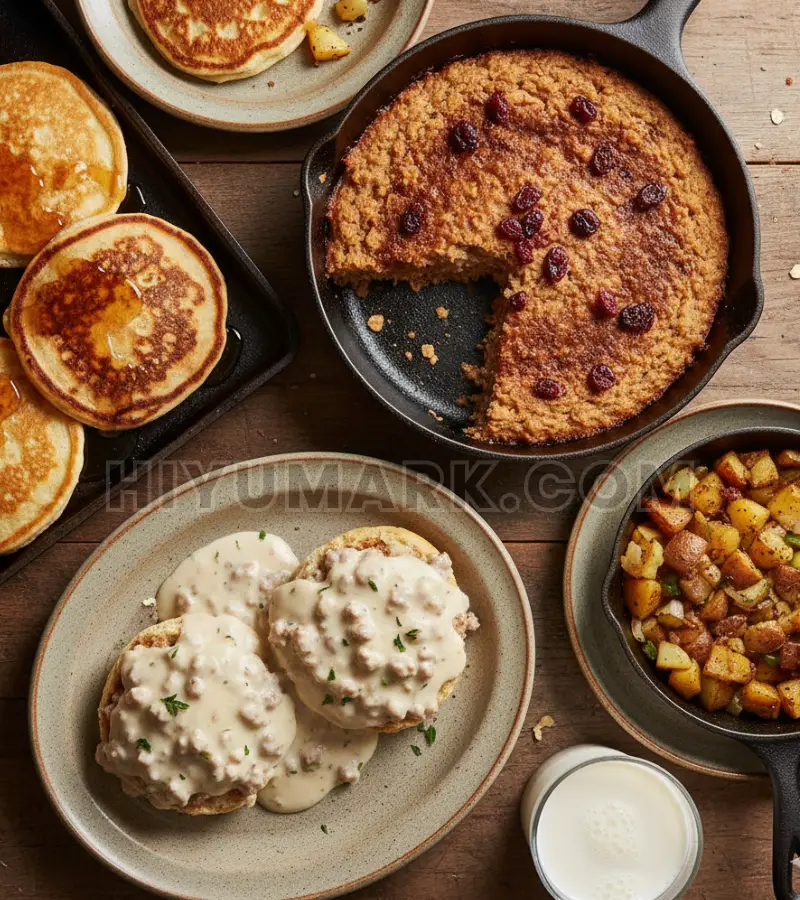
So yeah, if you’re tired of dry toast or protein bars pretending to be meals, this is probably your sign to go old-school. Amish-style.
In this article, you’ll find tried-and-true Amish breakfast recipes people actually make and swear by. Some are made for busy mornings, others for slow Sunday brunches where everyone grabs seconds.
Let’s get to the good stuff.
Most Popular Amish Breakfast Dishes
One thing Amish kitchens always seem to nail is breakfast.
Whether you’re in Lancaster County or just flipping through a tattered family recipe book, some dishes just keep showing up. They’re warm, filling, and often passed down through generations.
Here’s a closer look at the Amish breakfast recipes people talk about the most, cook often, and remember long after the plate is clean.
Amish Baked Oatmeal: A Warm, Filling Start to the Day
If your usual oatmeal feels more like punishment than breakfast, this Amish-style baked oatmeal might just flip the script for you.
Instead of that mushy, watery texture most folks complain about, this one comes out of the oven with a slightly crisp top and a soft, cake-like inside.
It’s the kind of thing you slice into squares and serve hot – sometimes with fresh cream, a drizzle of maple syrup, or just some seasonal fruit on top.
The ingredients? Nothing complicated. Just rolled oats, eggs, milk, brown sugar, a bit of cinnamon, and some baking powder to give it a little lift.
Amish cooks sometimes toss in raisins or apples for added texture and sweetness, but you can totally skip those if you’re not into fruity surprises.
What makes this dish special is how comforting and filling it is. One pan easily feeds the whole family, and leftovers reheat like a dream – so it’s great for meal prep or busy weekdays too.
Why people love it:
- No fancy tools or steps needed
- Stays good in the fridge for days
- Can be made ahead of time
- Works great for both breakfast and brunch
And no, it’s not just for cold mornings either. This baked oatmeal is good year-round, especially when you’re after something that feels homey but still hearty.
Amish Breakfast Casserole: Hearty, Cheesy, and Made to Feed a Crowd
If you’ve got a hungry table waiting or just want something that stays warm, fills you up, and doesn’t need babysitting, the Amish breakfast casserole is what you’re looking for.
At its core, it’s a mix of eggs, cheese, breakfast sausage, and shredded potatoes – baked into one golden, slightly crispy-topped dish. Think of it like a breakfast lasagna, but with fewer layers and way more cheese.
The texture is soft and fluffy on the inside, with enough chew from the meat and potatoes to keep it interesting.
You can prep the whole thing the night before, leave it in the fridge, and just toss it in the oven the next morning.
That’s one of the reasons Amish families – who usually cook for six, ten, or even twelve people – love this recipe so much. It’s dependable and stretches ingredients in a smart way.
Common ingredients you’ll see:
- Eggs (lots of them – 6 to 10 depending on batch size)
- Breakfast sausage or sometimes chopped ham
- Cheddar cheese or whatever’s on hand
- Frozen hash browns or grated fresh potatoes
- Milk and a bit of baking powder for fluff
Want to switch it up? Some folks add onions, bell peppers, or even spinach for extra color and flavor. Totally optional, though. The base version is rich and filling enough on its own.
Why it’s a go-to:
- Feeds a bunch of people without stress
- Tastes even better the next day
- Customizable with whatever’s in your fridge
- Perfect for potlucks, church gatherings, or slow Sunday mornings
Honestly, once you’ve made this a couple times, you’ll probably stop Googling “easy breakfast ideas” altogether.
Amish Pancakes: Fluffy, Filling, and Way Better Than Box Mix
There’s something about these pancakes that feels like waking up slow, with sunlight slipping through the curtains and the smell of butter hitting a hot griddle.
Amish pancakes aren’t about being fancy or packed with toppings. They’re more about that fluffy middle, that slight golden-brown edge, and the kind of buttery bite that makes you stop mid-chew like – “wait, why does this taste better than usual?”
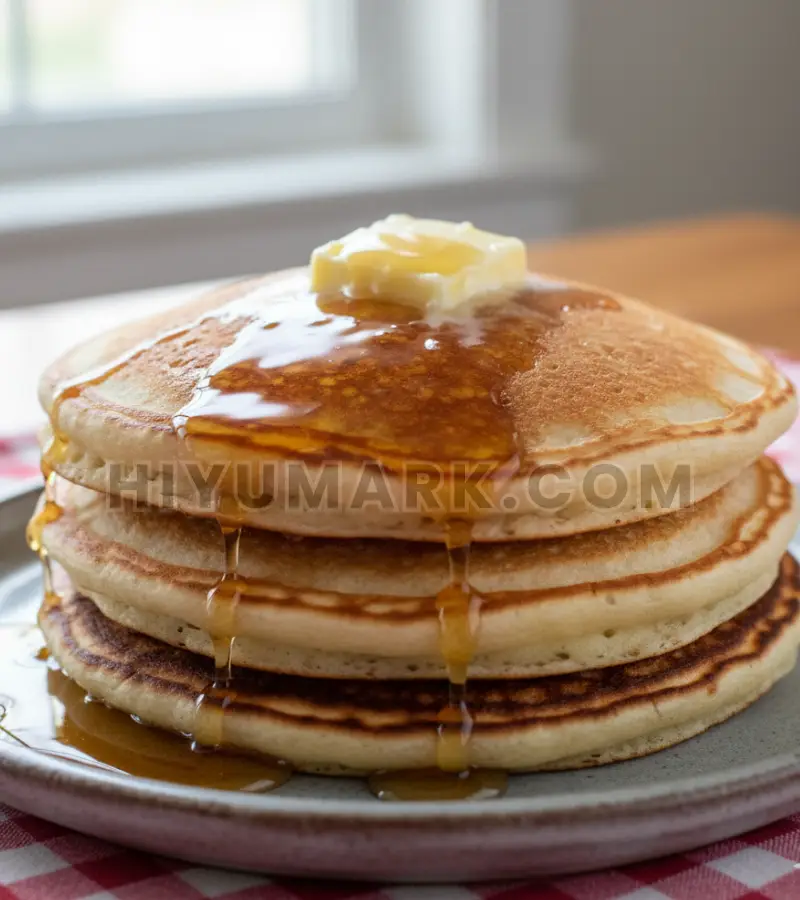
Most families use pantry stuff that’s always around – flour, milk, eggs, a pinch of baking soda, and just a touch of sugar.
But the trick? Amish folks often use buttermilk or even soured milk for a bit of tang and tenderness. That’s what gives them the soft-inside, crisp-outside vibe without needing anything artificial.
Pour the batter thick, let it bubble slow, flip once, and you’ve got a pancake that holds together without being too dense. These stack well too – which means syrup runs through the layers like a dream.
What makes them different from regular pancakes:
- No boxed mix, ever
- Uses real buttermilk or farm milk
- Slightly thicker batter, more like a spoon-pour than a pour-pour
- Lightly crisp edges with a rich center
Want to level it up the Amish way? Serve it with homemade apple butter, fresh jam, or maple syrup tapped right from the source. No need for whipped cream towers or chocolate chips – the point is simplicity that tastes real.
Oh, and by the way – these aren’t just for mornings. Amish families often eat breakfast foods for dinner too. So feel free to keep that skillet hot long after the sun goes down.
Amish Sausage Gravy: Thick, Creamy, and Made for Soaking into Biscuits
Forget those runny gravies or the kind that tastes like flour paste. This one’s rich, slow-cooked, and packed with crumbled sausage that leaves a little sizzle in the pan long after it’s done.
In Amish kitchens, breakfast sausage gets browned in a cast-iron skillet till the edges are just a little crispy. No draining needed – that fat stays in the pan and becomes the base.
Then in goes a spoonful or two of flour, cooked till it turns light golden. Next comes fresh milk, poured in slow, stirred till it thickens into a smooth, stick-to-your-ribs kind of gravy.
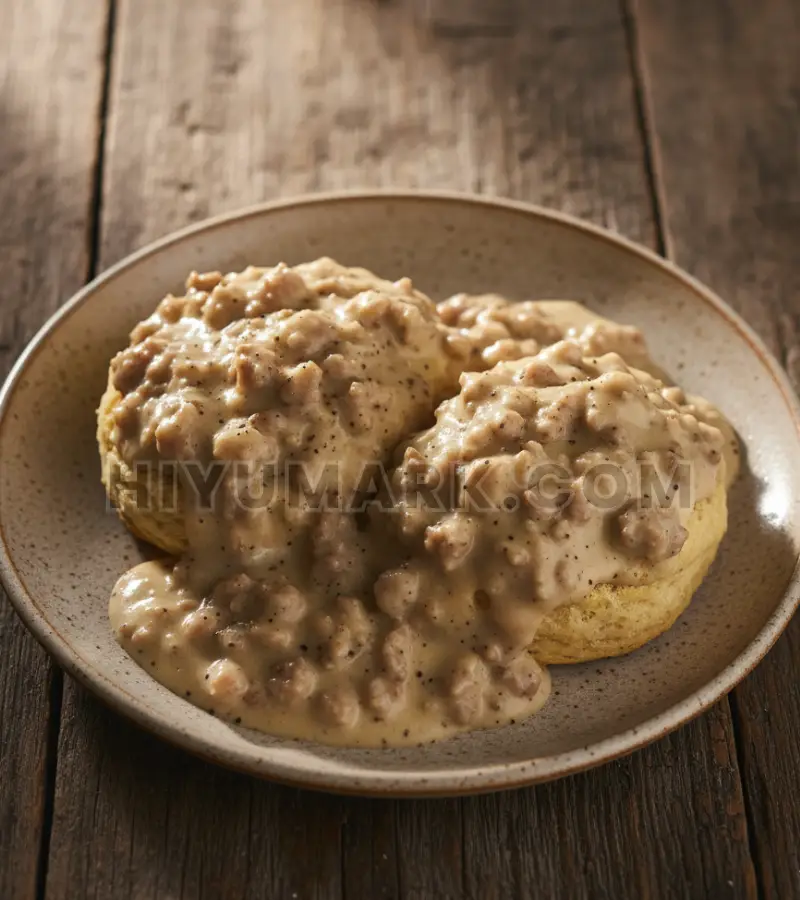
Black pepper usually gets added in generous amounts. Some families even sprinkle in a pinch of sage or nutmeg, just enough to give it that slightly deep, earthy note. But even without extras, the flavor comes through – bold, salty, and real.
Why this gravy hits different:
- Uses real sausage drippings, not butter or oil
- Gets thick without clumping
- Has that peppery bite everyone remembers
- Meant to be poured over hot biscuits, split open and steaming
Now let’s talk biscuits. Amish folks usually make their own – soft inside, lightly golden on the top, and just flaky enough to soak up gravy without falling apart. Buttermilk biscuits are the go-to, and they don’t use any fancy cutter either. Just scoop, drop, and bake.
Put the two together – hot biscuits, poured-over gravy – and you’ve basically got a breakfast people dream about and talk about for days.
Simple and satisfying? Don’t miss the full recipe Amish Sausage Gravy
Amish Cinnamon Rolls: Soft, Sticky, and Smell Like a Memory
Some breakfasts just taste like comfort, and these Amish-style cinnamon rolls come pretty close to that. They’re not dry, not bready, and definitely not from a tube.
Each roll is soft enough to pull apart with your fingers, filled with that warm cinnamon-sugar swirl, and topped with a glaze that melts right in instead of just sitting there.
Most Amish families make these on weekends, church mornings, or for guests staying over. The dough rises slow, with basic ingredients like flour, yeast, milk, sugar, and butter.
Nothing complicated, just stuff you’ve probably already got in your kitchen. Once the dough’s ready, it gets rolled out and covered with a thick layer of brown sugar, cinnamon, and more butter than you think is necessary. Trust it.
The rolls are then cut, placed snug in a pan, and baked until golden on top. They usually come out so soft that you can barely grab one without the others falling into it.
And the glaze? Just powdered sugar, a splash of vanilla, and a bit of cream or milk. Sometimes it’s poured on while the rolls are still hot, so it seeps down into all the cracks. Other times, it’s added after cooling for that frosted look.
Why these cinnamon rolls stay in people’s minds:
- Soft all the way through, not dry in the middle
- Sweet but not overloaded
- Perfect with a mug of strong coffee or fresh milk
- Made to be shared, not eaten alone
You can make them ahead, freeze them, or warm them back up the next day and they still taste like they just came out of the oven.
Amish Scrambled Eggs: Soft, Slow-Cooked, and Way More Than Just Eggs
Most folks throw eggs in a pan, stir for a minute, and call it done. That’s not how the Amish do it.
Their version? It’s slow, steady, and comes out creamy, soft, and rich enough to skip the toast if you want. These scrambled eggs are usually made in cast iron, over low heat, with lots of butter.
No rushing. The whole idea is to cook them just enough so they stay tender without going rubbery.
Some Amish cooks mix in heavy cream or whole milk, depending on what’s around. The goal’s not fluff – it’s silkiness. You’ll sometimes see chopped onions or farm cheese folded in near the end. Nothing overpowering. Just a bit of flavor that blends in quietly.
What sets these apart:
- Cooked low and slow for texture, not speed
- Made with farm-fresh eggs, often richer in color and taste
- Butter-heavy, no oil in sight
- Add-ins like onions, cheese, or even leftover ham for extra body
Amish households usually cook a big batch and serve it alongside fried potatoes, homemade toast, or just a slab of cheddar on the side. And no, nobody’s counting calories here – this breakfast is meant to hold you till mid-afternoon.
They may look simple, but once you taste them, you’ll get why folks keep going back to this basic, back-to-the-roots way of cooking eggs.
Simple and satisfying? Don’t miss the full recipe Amish Scrambled Eggs
Amish Cornmeal Mush: Golden Slices of Crispy Comfort
This one starts out looking like porridge but ends up something totally different – crispy on the outside, soft on the inside, and made to soak up syrup like a sponge.
Cornmeal mush begins simple: just cornmeal, water, and a pinch of salt, slowly cooked until it thickens into something thicker than oatmeal but smoother than grits. Then comes the Amish trick – pour it into a loaf pan, let it cool overnight in the fridge, and slice it up the next morning.
Each slice gets fried in butter, lard, or bacon grease until the edges turn golden and slightly crisp. The middle stays soft and warm, almost like polenta, but with a more rustic, hearty feel.
People usually serve it with:
- Maple syrup (classic choice)
- Molasses (for a deeper, old-school sweetness)
- Or just a pat of butter and a sprinkle of salt for savory lovers
Why it still shows up on Amish breakfast tables:
- Cheap and made from pantry basics
- Keeps well in the fridge for days
- Doubles as breakfast or a side dish for lunch
- Feels filling but not heavy
And no, it’s not just for the older folks. Kids love it too, especially with syrup. Some even eat it with apple butter or a splash of milk on top, depending on what’s around.
Amish Fried Potatoes: Crispy Edges, Soft Middle, and Always Made in Cast Iron
These aren’t those fast-food fries that go soggy in five minutes.
These are the slow-fried, golden-brown, crackling-edge kind of potatoes that you smell before you even walk into the kitchen.
Amish families usually slice up russet or red potatoes, skin on, and toss them in a hot pan with lard, bacon grease, or real butter. The pan? Almost always cast iron, seasoned from years of cooking – which adds a kind of flavor you can’t fake.
There’s no boiling first. No par-baking. Just raw potatoes, a bit of salt, and lots of patience. They go in and sit – no flipping too early.
That’s how you get that crusty bottom, the kind that makes a little crackling noise when your fork hits it.
Some extras they toss in, depending on the day:
- Chopped onions, browned till sweet
- A handful of bell peppers
- Sometimes leftover ham or sausage bits
- A little black pepper or paprika for some edge
These potatoes show up next to eggs, gravy, or even just a piece of toast with jam. And no matter how much you make, someone always wants a little more from the pan’s crispy corners.
Why these stay in rotation:
- Uses just a few ingredients
- No oven, no baking, just a skillet and time
- Works for breakfast, lunch, or dinner
- Can stretch to feed a big family
And the best part? The last few bites, scraped up from the bottom of the pan – the ones that are almost too crispy. Those are the ones people fight over.
Easy Amish Breakfast Recipes for Beginners
Not everyone wakes up ready to cook like a farmhouse pro – and you don’t have to. These easy Amish breakfast recipes are perfect for people who want something real but don’t have the time (or energy) to pull out five pans and half the spice rack.
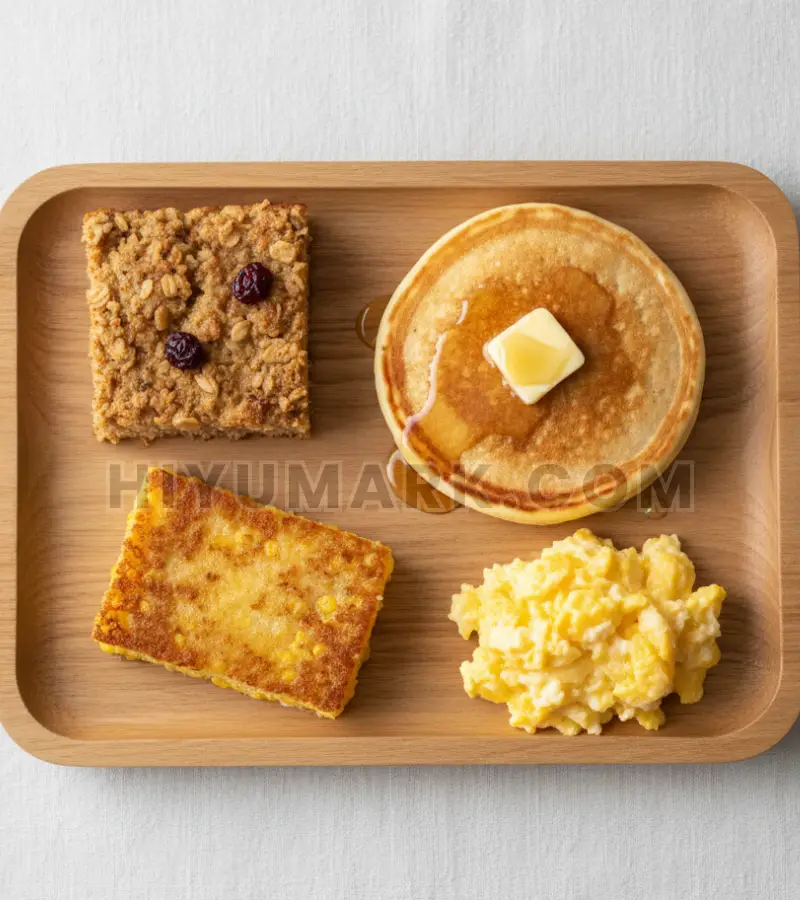
The goal? Fewer ingredients, faster prep, and food that still tastes like it came from someone’s grandma’s stove.
Simple 3–5 Ingredient Recipes
- Baked Oatmeal (basic version): Just oats, milk, eggs, sugar, and baking powder — mix and bake
- Amish Pancakes: Flour, eggs, milk, baking soda, sugar — quick, fluffy, filling
- Fried Cornmeal Mush: Yesterday’s mush, sliced and fried in butter — that’s it
- Buttermilk Biscuits: Flour, buttermilk, baking powder, butter, salt — flaky and fast
- Eggs + Potatoes Skillet: Cook together in one pan with salt and pepper — done in 10 minutes
One-Pot Amish Breakfast Options
- Breakfast Casserole: Toss together eggs, cheese, potatoes, and sausage in one baking dish
- Potato & Egg Scramble: Everything goes in one skillet, cooked low and slow
- Sausage Gravy: Sausage, flour, milk, salt, and pepper — all in one pan and poured over toast
- Oatmeal with Apple & Cinnamon: One pot, five minutes, warm and filling
Kid-Friendly Amish Recipes
- Amish Cinnamon Rolls (Mini version): Use smaller rolls – easier for little hands
- Sweet Corn Fritters: Slightly sweet, crispy outside, soft inside
- Buttered Noodles with Eggs: A quick Amish classic kids don’t say no to
- Jam Toast with Fresh Butter: Not just toast – this is usually homemade jam + churned butter
Quick Prep Amish Dishes for Weekdays
- Reheat baked oatmeal from earlier in the week — it gets better over time
- Fried eggs and toast with apple butter — classic, quick, satisfying
- Leftover casserole slices — heat and eat
- Pre-mixed pancake batter stored in the fridge for 2–3 days
- Scrambled eggs with leftover veggies — fast and smart way to use what’s there
These dishes aren’t about impressing anyone. They’re about starting your day with real food that works, even when mornings don’t.
Amish Breakfast Casseroles – Variations & Add-ons:
The best thing about an Amish breakfast casserole is that once you’ve got the base down – eggs, cheese, and something starchy – you can go in all sorts of directions.
Whether you’re feeding a crowd, prepping ahead, or just trying to use what’s already in your fridge, these casseroles are built to adapt.
Let’s break down the most common and most-loved versions.
Amish Egg Casserole with Hash Browns
This one’s a go-to in most homes. The base is simple: shredded hash browns, whisked eggs, milk, and shredded cheese. Add in cooked sausage, bacon, or keep it meat-free – either way, it bakes into a warm, cheesy, golden-topped dish that stays hot for a long time. Some sprinkle in green onions or paprika for extra flavor.
Tip: Use frozen hash browns to save time, and press them into the pan first to crisp up the bottom.
Make-Ahead Amish Casseroles
Casseroles are the ultimate prep-ahead breakfast solution. Many Amish families mix everything together the night before and refrigerate it. In the morning, just bake and serve. The texture even gets better when the ingredients have time to settle.
Popular combos:
- Eggs + bread cubes + ham + cheddar
- Sausage + potatoes + cream + eggs
- Zucchini + eggs + mozzarella for a lighter option
Prep tip: Cover with foil overnight to keep moisture in, then remove foil halfway through baking to get that crisp top.
Amish Ham and Cheese Bake
Leftover ham from dinner? It usually ends up here. Mixed with chunks of bread, sharp cheese, a little mustard, and farm eggs, this casserole has more of a savory, sharp bite. Some add in chopped bell peppers or even spinach for a bit of green.
It’s filling, simple, and makes great leftovers.
Meatless Options
Not every Amish dish has to be meat-heavy. Plenty of casseroles skip the sausage and still come out rich and satisfying.
Meat-free ideas:
- Spinach and mushroom egg bake with Swiss cheese
- Potato and cheddar casserole with herbs
- Zucchini and onion egg bake for a garden-fresh vibe
- Cheese strata with thick slices of day-old bread and milk-soaked eggs
These versions are not only lighter but usually cheaper too – and perfect for guests with dietary restrictions.
No matter which version you go with, Amish breakfast casseroles are built to be shared, reheated, and remembered. And they usually leave just enough in the pan for someone to sneak one more bite.
Hearty Amish Breakfasts for Big Families
In Amish homes, it’s rarely breakfast for one. The table is long, the chairs are full, and the food has to go a long way. That’s why hearty, budget-friendly, large-batch breakfasts are more of a necessity than a choice.
Most of these meals are built around a few key ideas: stretch what you have, don’t waste anything, and make sure there’s enough for everyone to go back for seconds.
Large Batch Cooking Tips
- Double up recipes like casseroles or baked oatmeal and use deep baking pans
- Keep one hand on the cast iron skillet — it can handle big quantities and holds heat longer
- Use leftovers creatively, like adding yesterday’s potatoes to today’s eggs
- Prep dry mixes ahead of time (for pancakes, mush, etc.) and store in jars
- Bake once, eat twice — many Amish meals are made in large portions to reheat the next day
Budget-Friendly Amish Breakfasts
- Cornmeal mush — dirt cheap and feeds a crowd
- Eggs and potatoes — two farm staples that show up in dozens of ways
- Homemade bread — one loaf can stretch across toast, sandwiches, and sides
- Scrambled eggs with garden vegetables — no meat needed, just flavor
- Gravy with biscuits — uses sausage scraps and flour, but fills people up fast
Recipes That Stretch Ingredients
- Amish breakfast casserole — combines eggs, cheese, potatoes, and meat into one pan
- Fried mush — turn yesterday’s mush into today’s crispy breakfast
- Baked oatmeal — fill it with apples, raisins, or whatever fruit’s starting to turn
- Amish pancakes — make a big batch and freeze extras for later
- Shoofly pie — one pie, eight slices, and everyone’s smiling
The whole idea is simple: cook smart, serve plenty, and keep it homemade. In Amish kitchens, the food doesn’t just feed – it brings people together. And whether it’s two kids or twelve around the table, there’s always enough to go around.
Authentic Amish Breakfast Tips (From Real Amish Communities)
Amish cooks rarely follow strict recipes. They rely more on what’s available, what’s fresh, and what didn’t go to waste the day before.
You’ll often see garden vegetables added to eggs, day-old bread turned into casseroles, and jams or pickles brought out from jars sealed months ago.
Most meals are made using basic tools like cast iron pans, wooden spoons, and hand mixing. No fancy appliances.
The food turns out richer, slower, and somehow warmer because it’s made by hand, not by machine. Batches are cooked big on purpose so leftovers can stretch into lunch or dinner the next day.
And finally, breakfast isn’t rushed. It’s early, but never frantic. The whole family sits down together, food is passed around, and there’s time to enjoy what’s on the plate. That shared table, more than any single ingredient, is what makes it feel Amish.
Amish Breakfast Drinks & Sides
An Amish breakfast table isn’t complete with just casseroles, eggs, or oatmeal. There’s always something extra on the side – a warm drink, something tangy or sweet, or a homemade spread passed down from the cellar.
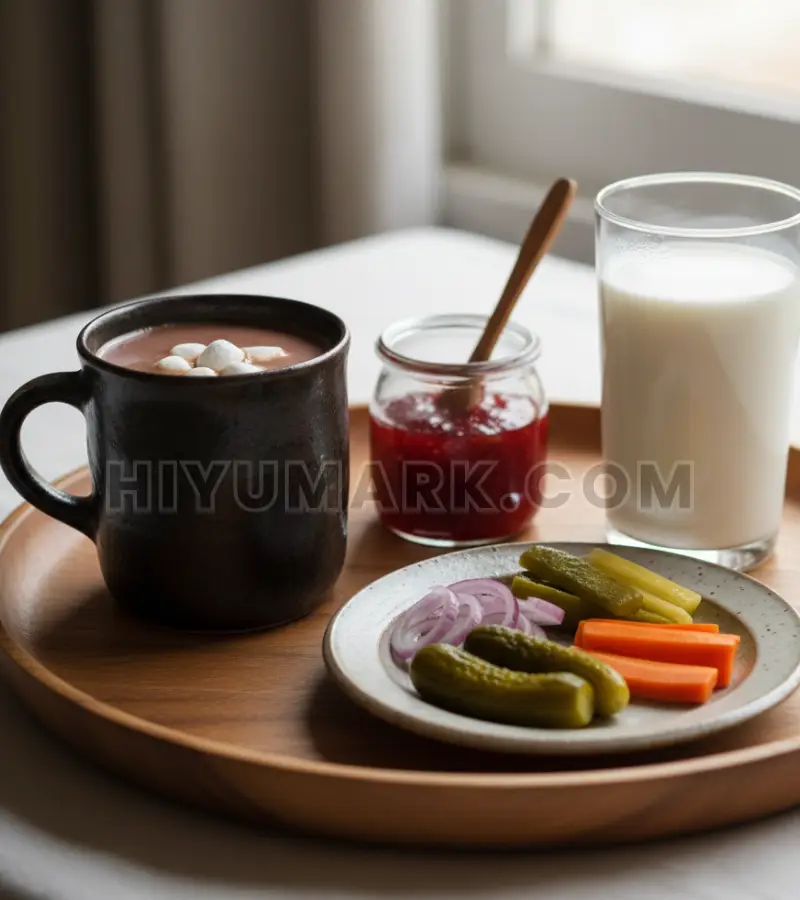
These little additions don’t just fill the plate, they round out the whole meal in a way that feels simple, yet thoughtful.
Amish Hot Cocoa
Forget the powdered packet stuff. Amish hot cocoa is usually made from scratch with real cocoa powder, sugar, a pinch of salt, and whole milk.
It’s warmed slowly on the stove, not microwaved, and finished with a bit of vanilla. Some folks even add a knob of butter to make it extra creamy. It’s served steaming hot in big mugs, often next to a cinnamon roll or a fresh biscuit.
Dandelion Coffee
This one’s different. There’s no actual coffee in it. It’s made from roasted dandelion roots. The roots are cleaned, dried, roasted until dark and aromatic, then ground and brewed like regular coffee.
The result is a bitter, earthy drink that feels a bit like black coffee but without caffeine. It’s a common choice in households that avoid store-bought goods or prefer herbal options.
Fresh Buttermilk
Not the store version that comes in cartons. This is usually what’s left after making homemade butter, and it’s poured straight into a glass. It’s thick, slightly tangy, and usually chilled.
Some drink it plain; others sprinkle in a pinch of salt or black pepper. It cuts through rich foods and is often sipped alongside heavy dishes like sausage gravy or fried mush.
Pickled Vegetables as Sides
You might not think of pickles for breakfast, but in Amish kitchens, pickled beets, cucumbers, green beans, or even pickled eggs show up regularly.
They’re jarred in vinegar and spices, made months ahead, and pulled out when fresh veggies aren’t in season. The tanginess balances out the richness of the main dishes.
Homemade Jams and Butters
These spreads are almost always made in big batches during harvest season and stored in jars for the rest of the year. Think strawberry preserves, apple butter, peach jam, or grape jelly – all thick, chunky, and sweet without being too sugary. Spread over homemade bread, pancakes, or biscuits, they turn something simple into something you remember.
Together, these drinks and sides add flavor, balance, and a kind of quiet comfort to the whole meal. Not fancy, not overdone – just made with care.
Are Amish Breakfasts Healthy?
In some ways, yes – and in others, not really.
Amish breakfasts are made from scratch, with whole ingredients, fresh dairy, garden vegetables, and bread baked at home.
There are no preservatives, no additives, and nothing ultra-processed. That alone makes a big difference in how the food sits in your body.
But these meals are also heavy on fats, carbs, and animal products. Butter, sausage, gravy, whole milk, and sugar show up often. It’s filling, no doubt – but not exactly light.
The key, though, is how they eat. Amish folks typically burn thousands of calories a day doing manual labor, walking, farming, and working outside. The food fits that lifestyle.
For people living less physically active lives, this kind of breakfast might be better as an occasional treat than a daily habit.
Still, take away the excess and keep the homemade part – and you’ve got a solid foundation for something that feels good and tastes right.
How to Make an Entire Amish Breakfast Spread?
Pulling off a full Amish breakfast isn’t about cooking ten things at once – it’s about smart prep, simple recipes, and serving them all warm at the same time.
Here’s how most Amish kitchens do it, step by step.
Start with something that bakes – like a breakfast casserole or baked oatmeal – and get that in the oven first. While it’s baking, use the stovetop for quick items like scrambled eggs, fried potatoes, or cornmeal mush slices. These don’t need much attention if your heat is low and steady.
Last step: lay out the extras. Slice up homemade bread, set out jams, pour fresh buttermilk, and reheat any gravy or cocoa if made earlier. Once everything’s hot and ready, it all goes on the table, family-style. No plating. Just pass, serve, and eat while it’s still warm.
Frequently Asked Questions
What Makes Amish Oatmeal Different?
It’s usually baked, not boiled. That one change gives it a totally different feel – more like a soft breakfast cake than a bowl of mush. Also, it’s sweetened with brown sugar or molasses and often topped with fruit or fresh cream. No instant packets here.
Can You Use Modern Appliances for Amish Recipes?
Yes, absolutely. While the Amish often cook with wood stoves and hand tools, most of their recipes can be made with regular ovens, mixers, and stovetops. The ingredients are simple, so you don’t need fancy equipment to get the taste right.
How Do Amish Cook Without Electricity?
Many use wood-burning stoves, propane, or coal ovens. Some have gas-powered fridges and non-electric tools. It’s more about method and timing than speed. Meals take longer, but that’s part of the flavor.
Why Do Amish Breakfasts Taste So Much Better?
Most of it comes down to fresh, local ingredients and slow cooking. Butter churned at home, eggs from the backyard, no shortcuts. Add in cast iron pans and patience, and the food just ends up tasting more real.
What’s the Best Amish Breakfast Recipe for Guests?
Go with a breakfast casserole – it’s easy to prep ahead, fills everyone up, and feels hearty without being too fancy. Serve it with homemade bread, jam, and hot cocoa, and you’ve got a table that makes people stay longer than they planned.
You Might Also Like:
